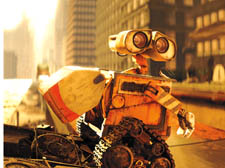|
|
 |
| |

Wall-E gathers Earth’s rubbish after the planet is deserted by humans |
Wall-E. It’s Wall over for Earth as the robots clean up
WALL-E
Directed by Andrew Stanton
Certificate U
HATS off to director Andrew Stanton and the dweeby minions at Pixar.
In Wall-E, they have created a film that is technically stunning, brilliant to look at, cute without being cringy and which carries a stunning, simple message about the state of the planet. This is the children’s film of the 21st century.
A quick plot outline: Wall-E is a robot programmed to scoop up all the rubbish that us humans have left lying around. He is alone. The Earth is deserted, just one big toxic dump. Humans jumped on spaceships 700 years previously, leaving robots behind to deal with the junk, scoop it up and compact it, with the view that humans can, perhaps, one day return.
Then a droid called Eve is sent by our cosmos-travelling race to see how Earth is getting on and meets Wall-E, who shows her around and leads her to a discovery that changes the course of history.
It has a hint of HG Wells’s The Time Traveller, telling of a technologically advanced human race enraptured with pleasure-seeking – and the detrimental side-effects. Other references include Kubrick’s 2001 and One Flew Over The Cuckoo’s Nest.
Visually it is the most accomplished animated film there has ever been, bar none: it would work on the wall of a contemporary art gallery. The depth of colour and sense of perspective is mind-boggling. One scene, featuring the two heroes floating through space, is like being at the ballet.
Then there is the sound.
The dialogue consists of creaks, whistles, beeps, pistons, motors – the robots do not speak, of course they don’t! There is humour in the noises, too. When Wall-E is fully charged, he pings – you’ll recognise that sound as the start-up noise of the old iMac, all created by the man who made R2D2 speak in Star Wars.
But there is more to Wall-E than wonderful artwork and a cracker of a tale.
The makers are telling us that the 20th century is truly dead. Wall-E’s task is to clear up the detritus of the age of mass production and of mass communication. There is a direct link between the first Model T Ford that trundled off the production line and Wall-E, the last mass-produced robot left on Earth.
While the Ford ushered in the era of mass ownership, Wall-E represents the death of the mechanical age. No longer can we consider the materials that provide us with the means of production to be infinite.
There are clear links between the shiny futuristic world which the 1920s capitalists used to sell their must-have mod-cons.
The skyscrapers of crushed rubbish Wall-E is programmed to build mimic the vision of William Van Alan’s Chrysler building in New York. In the film of The Great Gatsby, there are road signs selling the products no self-respecting American can do without – no goods, no American Dream, we are told.
In Wall-E, the defunct advertising signs (which look suspiciously like banners for Wal-Mart malls) are smeared in toxic goo and proclaim the death of the use of images for mass sales – a revolutionary statement for a Walt Disney company to make. |
 |
|
 |
| |
|
 |
|

